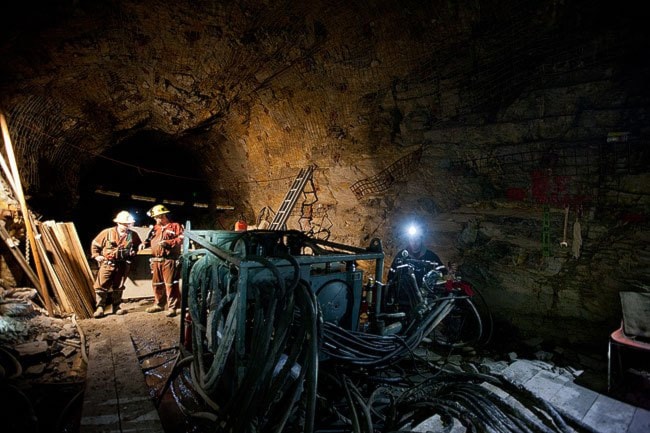CANTUNG MINE
Armed with two newly announced tungsten ore pockets, a new water-treatment facility and $52 million in infrastructure investment, North American Tungsten’s Cantung mine is the two-year mine that just keeps on giving.
“We just keep stumbling into more ore. We are looking at the old mine, and areas they maybe hadn’t touched. Everywhere we sink a hole, we hit ore,” said senior geologist Ehsan Salmabadi.
Salmabadi and mine manager Jason McKenzie both went through the mine’s recent 2010 start-up process. It was shut down for a year in 2009 when tungsten prices fell through the floor, but now that the commodity boom is picking up speed there is money to be made again.
“It was a rough start because they had the place dismantled. There were a lot of upgrades,” McKenzie said.
That’s the story of Cantung, and it’s been running that way with only two years worth of defined resources since the ‘60s - on again, off again at the whim of the markets.
“When I started here in 2008, they told me it could be five months or five years,” says Chris LaForge, one of the mine’s mill workers.
“They’re still telling that to new guys who come on board.”
In the last couple of years, the mine has seen rapid expansion. North American Tungsten has dropped $52 million into the property that sits mere metres east of the N.W.T./Yukon border in the Nahanni mountain range. They fixed up the mill, provided better accommodations for the staff and have been drilling the mountain into swiss cheese. That has helped the company define more and more resources.
Last week it announced plans to start mining two new areas - the Dakota and Amber zones. Right now Cantung produces more than four per cent of the world’s tungsten.
Not only that, but North American Tungsten is also quickly closing in on its proposed Mactung project. A few hundred kilometres farther north along the border, Mactung is the largest defined tungsten reserve in North America. The company predicts Mactung could have a 30-year life span, and employ almost 300 people.
This week the company even received accolades from some environmentalists, a rare feat for a mining company. It announced that it is withdrawing plans to build a new road from Ross River to the Mactung site and will instead use the existing spur road that branches off from the North Canol road into the N.W.T.
With all this development, North American Tungsten isn’t slowing down any time soon.
Cantung sits just inside the N.W.T., but all of the business revenue flows through the Yukon. The mine even operates on the Yukon time zone. While it’s considered an N.W.T. mine for regulatory and permitting purposes, for all intents and purposes it belongs to the Yukon.
It was first opened in the 1960s by Canadian Tungsten (hence its name), and was a bustling town of almost 600 people. There was an RCMP post here and two schools. The kids were flown to Yellowknife for high school and brought home on the weekends.
There was also a medical clinic and a jail. There was even a travel agent, a hairdresser, a post office and three different bars, all in a place that now houses only about 140 people per shift. It seems like a skeleton crew compared to the old days.
Most of the old buildings are still here. The long-empty town houses march off in a row down the valley. The jail is boarded up. The rec centre got hit by an avalanche and now its swimming pool and bowling lane sit empty, but McKenzie has plans for those buildings. He wants to fix them up and put them to good use.
“I want to turn the old medical clinic and jail into permanent offices for our environmental department,” said McKenzie.
Turnover among the staff is high, especially among the underground workers, but Salmabadi, for one, isn’t going anywhere. After coming through the 2010 startup, he’s proud of the work they are doing.
“I believe in this place. Lots of people do. To be honest, with the experience that I’ve gained, there are jobs out there for me. Finding a job elsewhere wouldn’t be difficult. I stick around because it’s exciting to be on the edge of something big,” said Salmabadi.
But as impressive as North American Tungsten’s two projects are, the company still has its detractors.
The looming confrontation between the Kaska First Nations and the territorial government could see the North Canol road - the only access for the Cantung and Mactung sites - blockaded this summer.
Liard First Nation Chief Liard McMillan said that while there have been some jobs for Liard First Nation citizens, there have also been a lot of issues with the mine and the company refusing to include the First Nation in negotiations.
“In the 15 years that I’ve been involved on that file, they kept saying when they reopened the mine that it was going to be a two- to three-year mine life,” said McMillan. “Well, it’s gone like five times beyond that and we haven’t seen any benefit from it. I think that unless things improve in a hurry ... we may be looking at opposing Mactung, and quite vigorously, whether it’s blockades or civil legal action, all of those things are on the table.”
Contact Jesse Winter at
jessew@yukon-news.com
